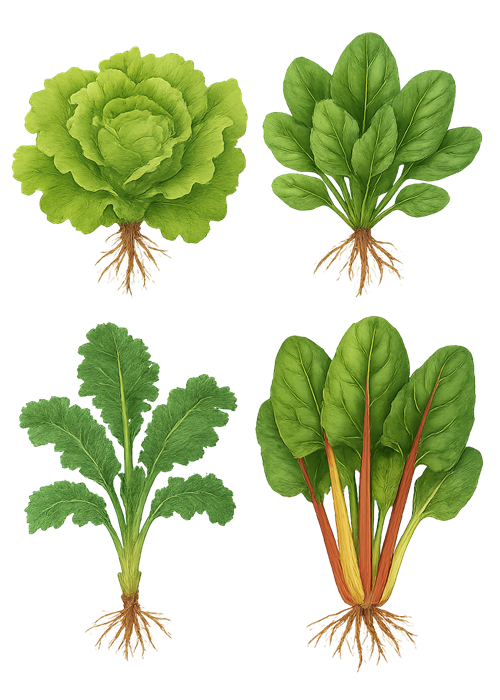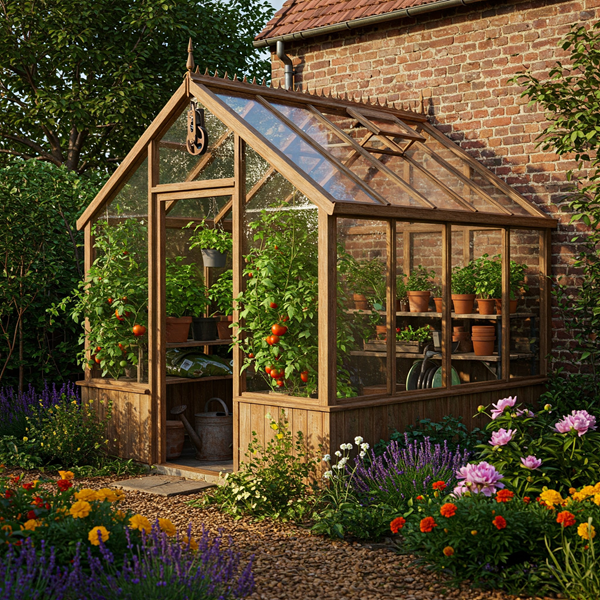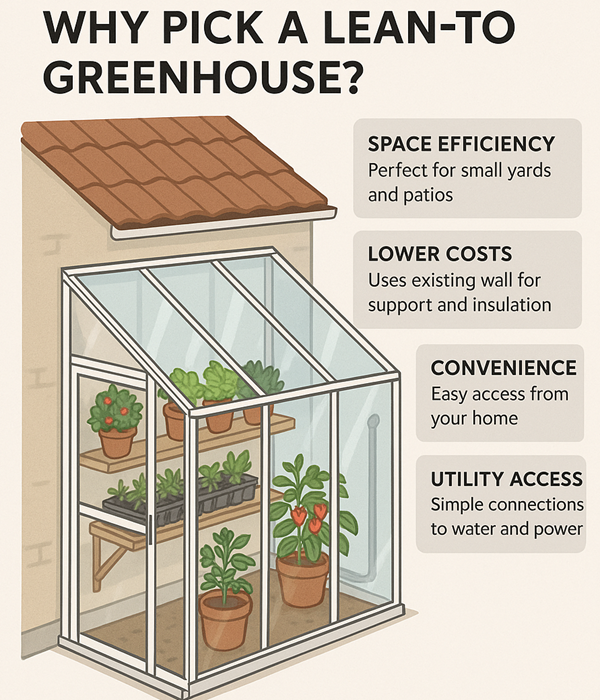Lean-to Greenhouse:
The Smart Way to Garden When Space is Tight
Lean-to Greenhouse
| Material | Pros | Cons |
| Aluminum | Light, rust-free, low maintenance | Not very strong-looking |
| Wood | Stylish, insulates well | Needs regular upkeep |
| Steel | Super strong | Heavy, harder to install |
| Glass | Clear, lots of light | Breakable, poor insulation |
| Polycarbonate | Tough, insulates well | Not crystal clear |
| Acrylic | Durable, shatterproof | Scratches easier, pricier |
What’s a Lean-to Greenhouse, Anyway?
Think of a lean-to greenhouse as a greenhouse with a shortcut. Instead of standing on its own, it leans against one of your existing walls—like your home, garage, or shed. It only needs three walls of its own, and it uses your existing wall for extra support and insulation. That makes it super efficient when it comes to heat retention and material use. These greenhouses come in all shapes and sizes. Some are long and narrow, perfect for lining a side wall, while others stretch across the back of a house. Whether you go the custom-built route or grab a ready-made kit, they’re a smart way to make the most of your available space.
Why Pick a Lean-to Greenhouse?
- Space efficiency: Lean-to greenhouses are awesome for small yards, patios, or even balconies because they don’t take up as much room as freestanding greenhouses.
- Lower costs: Since they borrow one of your existing walls, they save on materials, and that wall helps trap warmth—especially handy during cooler months.
- Convenience: With the structure so close to your home, you can check on your plants without bundling up or walking far.
- Utility access: You can tap into your home’s water or power lines more easily, cutting down on setup hassles and costs.
Things to Think About Before You Build
- Sunlight: You’ll want to position your greenhouse so it gets at least six hours of direct sun every day. In most places, that means attaching it to a south-facing wall. East or west walls can also work.
- Ventilation: Even in winter, greenhouses can get hot fast. Add roof vents, side vents, or a small exhaust fan to regulate temperature and airflow.
- Water and drainage: Make sure you’ve got a nearby water supply and that the floor drains well to avoid soggy soil and mold.
- Insulation: For year-round growing, use double-pane panels, weather stripping, and thermal curtains to trap heat.
- Permits: Depending on your location, you might need a permit—especially if it connects to your house. Always check with your local building department first.
Choosing the Right Materials
Framing materials:
- Aluminum: Lightweight, rust-resistant, and low maintenance.
- Wood: Attractive and well-insulating but needs more upkeep.
- Galvanized steel: Strong and rust-proof, great for bigger builds.
Glazing materials:
- Glass: Offers great clarity but is heavier and more fragile.
- Polycarbonate: Light, durable, and great for insulation.
- Acrylic: Clear and shatterproof, a solid all-around choice.
Flooring options:
- Gravel: Cheap and drains well.
- Concrete: Durable and easy to clean.
- Pavers: More polished-looking, good drainage.
- Packed soil: Budget-friendly, though less durable.
DIY vs. Prefab: Which Way to Go?
DIY lean-to greenhouse:
- Full control over the design.
- Cost-effective if you have tools and know-how.
- Takes more time and effort.
Prefab kits:
- Quicker to assemble with all parts pre-cut.
- More expensive upfront but easier to install.
- Look for modular kits so you can expand later.
Design Ideas to Make the Most of It
- Use vertical space: Add shelves, wall racks, and hanging baskets.
- Add thermal mass: Use water barrels or rocks to store and release heat.
- Set up rainwater collection: Use a gutter on the roof to fill barrels.
- Install smart tools: Try timers, sensors, and auto-watering systems.
Common Pitfalls to Avoid
- Shady placement: Don’t build your greenhouse where it won’t get enough sun.
- Poor airflow: Lack of ventilation leads to heat and humidity problems.
- Underinsulating: One-layer plastic might not cut it in winter.
- Skipping the foundation: Uneven or soggy flooring creates problems later.
What to Grow in Your Lean-to Greenhouse
Cool-season crops:
- Lettuce
- Spinach
- Kale
- Swiss chard

Warm-season plants:
- Tomatoes
- Cucumbers
- Eggplants
- Peppers

Herbs and ornamentals:
- Basil
- Mint
- Thyme
- Orchids
- African violets
- Succulents
Keeping Your Lean-to Greenhouse in Great Shape
- Clean panels regularly: Keep sunlight flowing by washing off dirt and algae monthly.
- Watch for pests: Inspect plants before bringing them in and seal openings.
- Organize tools: Use shelves and hooks to save space and stay efficient.
Make seasonal changes:
- In winter: Add heat, insulation, and thermal blankets.
- In summer: Increase airflow and add shade cloth.
Now that we have a clear understanding of the factors to consider, let’s explore some top recommendations for Lean-to Greenhouses that meet these criteria.
Top Recommendations for Lean-to Greenhouses
Greenhouse A:
Features and Benefits About the EAGLE PEAK Lean-to Greenhouse: Superior Craftsmanship: EAGLE PEAK’s greenhouse is built to last. The sturdy powder-coated steel frame promises longevity, while its UV-protected and water-resistant cover ensures your plants get sunlight and humidity without excess moisture.
Easy Accessibility: Featuring two expansive roll-up zipper doors, this greenhouse ensures simple access to your plants and fosters optimal air circulation for a healthier growth environment. Included Shelving: Elevate your gardening experience with an included flower rack. With EAGLE PEAK, setting up your greenhouse is a breeze, no tools needed – have it ready in mere minutes.
Generous Gardening Space: Enjoy a spacious gardening environment in this walk-in greenhouse, measuring L 10 ft x W 5 ft x H 7 ft. Thoughtfully designed, it’s ideal for placement beside your barn, garage, or shed door, optimizing your outdoor space.
The EAGLE PEAK Commitment: We stand by our products. Benefiting from a 1-year limited warranty from the purchase date, you’re ensured quality and durability. For any inquiries, our expert service team is eager to assist. EAGLE PEAK’s greenhouse seamlessly combines functionality with durability, ensuring a superior gardening experience. Embrace the joy of gardening with EAGLE PEAK!
Greenhouse B:
Features and Benefits
-
- Virtually unbreakable 4 mm twin-wall polycarbonate roof panels block up to 99.9% of UV rays and diffuse sun light eliminating the risk of plant burn and shade areas
- STURDY THOUGHTFUL CONSTRUCTION WILL LAST A LIFETIME – Chosen by Better Homes and Gardens as the Best Overall Greenhouse Kit of 2024. Panels block harmful UV rays to protect plants from sun overexposure. The sturdy, oxidation resistant powder coated aluminum frame includes a galvanized steel base to add structural stability.
- Rust resistant aluminum frame extends 7′-5″ from floor to peak
- Kit Includes adjustable roof vent, rain gutters, lockable hinged door with magnetic catch, aluminum frame, polycarbonate panels and a galvanized steel base
- Withstands winds up to 47 mph and supports snow loads of up to 15.4 lbs. per sq. ft.
🔑 Key Takeaway
A lean-to greenhouse helps you garden efficiently in tight spaces. It saves energy, keeps your plants close, and extends your growing season without taking over your yard.
Conclusion
A lean-to greenhouse is perfect for gardeners with limited space. It’s convenient, energy-efficient, and makes year-round growing possible. With the right setup and planning, you can create a cozy plant paradise right outside your door. Whether you’re a beginner or experienced, it’s an ideal space for growing both your garden and skills. Key Takeaway: A lean-to greenhouse helps you garden efficiently in tight spaces. It saves energy, keeps your plants close, and extends your growing season without taking over your yard.
Frequently Asked Questions (FAQs): Lean-To Greenhouses
Can I add a lean-to greenhouse to my garage or shed?
Yes, you can attach a lean-to greenhouse to a garage, shed, or almost any solid wall that gets good sunlight.
-
-
Why it works: Lean-to greenhouses are designed to use an existing wall as one side of the structure, saving space and materials. Garages and sheds are great options as long as the wall is sturdy and faces the sun for most of the day.
-
Things to consider: Make sure the wall is in good condition and free from leaks or rot. South- or west-facing walls are ideal for maximum sunlight.
-
Benefits: This setup saves money on construction, makes use of underutilized space, and can even provide easy access to utilities or storage inside your garage or shed.
-
Is it okay to use solar panels to power fans or heaters inside?
Yes, solar panels are a smart and sustainable way to power greenhouse systems.
-
-
How It Helps: Solar panels power lights, fans, and small heaters, boosting energy efficiency and cutting down your dependence on the grid.
-
Off-grid advantage: This is especially useful if your lean-to is far from your home’s electrical supply or if you want an eco-friendly, off-grid solution.
-
What to know: The number of panels you need depends on the power requirements of your equipment. For fans and LED lights, a small solar setup is often enough. For heaters in cold climates, you may need a larger system or a backup power source for cloudy days.
-
Can I use grow lights in a lean-to greenhouse?
Yes, grow lights can be very helpful, especially in winter or cloudy regions.
-
-
Why use them: Lean-to greenhouses sometimes get less light due to their location or the angle of the sun, especially in winter.
-
How to use: Install LED grow lights or fluorescent fixtures above your plants to supplement natural sunlight. This ensures your crops get enough light for healthy growth and strong yields.
-
Tips: Use a timer to mimic natural day length, and choose lights with a spectrum suitable for the types of plants you’re growing.
-
What’s the best way to heat a lean-to greenhouse?
Combine electric heaters with thermostats or passive heating systems like water barrels for best results.
-
-
Electric heaters: Small electric heaters with built-in thermostats provide steady, reliable warmth and are easy to control.
-
Passive heating: Place water barrels or other thermal mass materials inside the greenhouse. They absorb heat during the day and release it at night, helping to moderate temperature swings.
-
Insulation: Add bubble wrap or insulated panels to the glazing and seal any gaps to keep heat in and cold out.
-
Efficiency: Proper insulation and passive heat storage make any heating system more effective and help lower energy costs.
-
Can I build one against a brick wall?
Yes, brick walls are actually one of the best choices for lean-to greenhouses.
-
-
Thermal Power of Brick: During the day, brick stores solar heat and slowly releases it after dark, reducing temperature swings inside the greenhouse.
-
Durability: Unlike wood, brick won’t warp or rot from the humidity inside the greenhouse.
-
Extra tip: If you’re planting directly into the ground, make sure moisture doesn’t collect at the base of the wall to avoid any long-term issues with your foundation.
-







